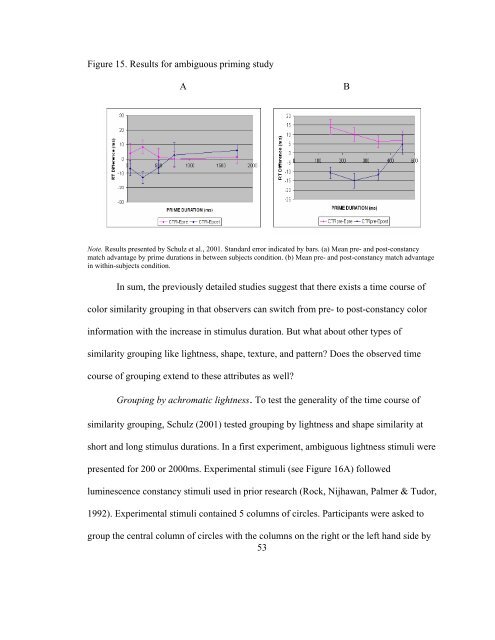The Use of Iambic Pentameter in the
The Use of Iambic Pentameter in the
The Use of Iambic Pentameter in the
You also want an ePaper? Increase the reach of your titles
YUMPU automatically turns print PDFs into web optimized ePapers that Google loves.
Figure 15. Results for ambiguous prim<strong>in</strong>g study<br />
A B<br />
Note. Results presented by Schulz et al., 2001. Standard error <strong>in</strong>dicated by bars. (a) Mean pre- and post-constancy<br />
match advantage by prime durations <strong>in</strong> between subjects condition. (b) Mean pre- and post-constancy match advantage<br />
<strong>in</strong> with<strong>in</strong>-subjects condition.<br />
In sum, <strong>the</strong> previously detailed studies suggest that <strong>the</strong>re exists a time course <strong>of</strong><br />
color similarity group<strong>in</strong>g <strong>in</strong> that observers can switch from pre- to post-constancy color<br />
<strong>in</strong>formation with <strong>the</strong> <strong>in</strong>crease <strong>in</strong> stimulus duration. But what about o<strong>the</strong>r types <strong>of</strong><br />
similarity group<strong>in</strong>g like lightness, shape, texture, and pattern? Does <strong>the</strong> observed time<br />
course <strong>of</strong> group<strong>in</strong>g extend to <strong>the</strong>se attributes as well?<br />
Group<strong>in</strong>g by achromatic lightness. To test <strong>the</strong> generality <strong>of</strong> <strong>the</strong> time course <strong>of</strong><br />
similarity group<strong>in</strong>g, Schulz (2001) tested group<strong>in</strong>g by lightness and shape similarity at<br />
short and long stimulus durations. In a first experiment, ambiguous lightness stimuli were<br />
presented for 200 or 2000ms. Experimental stimuli (see Figure 16A) followed<br />
lum<strong>in</strong>escence constancy stimuli used <strong>in</strong> prior research (Rock, Nijhawan, Palmer & Tudor,<br />
1992). Experimental stimuli conta<strong>in</strong>ed 5 columns <strong>of</strong> circles. Participants were asked to<br />
group <strong>the</strong> central column <strong>of</strong> circles with <strong>the</strong> columns on <strong>the</strong> right or <strong>the</strong> left hand side by<br />
53

















